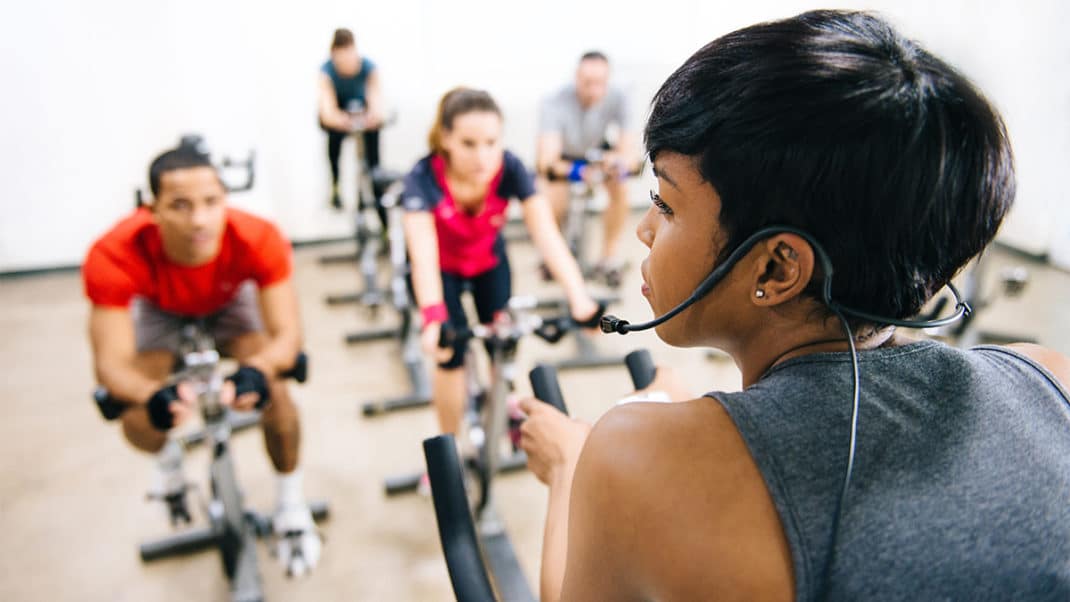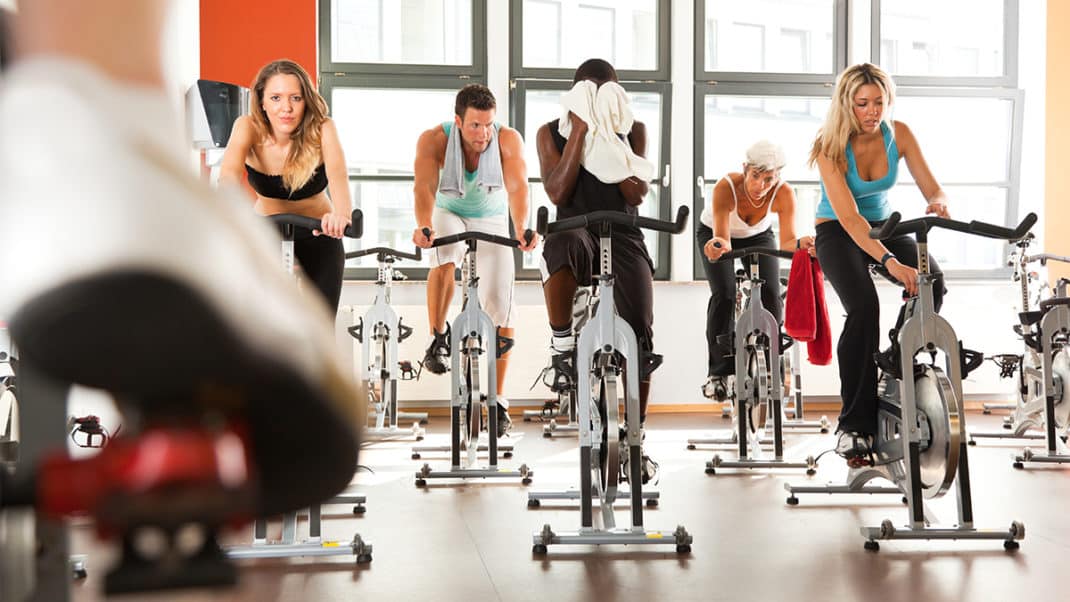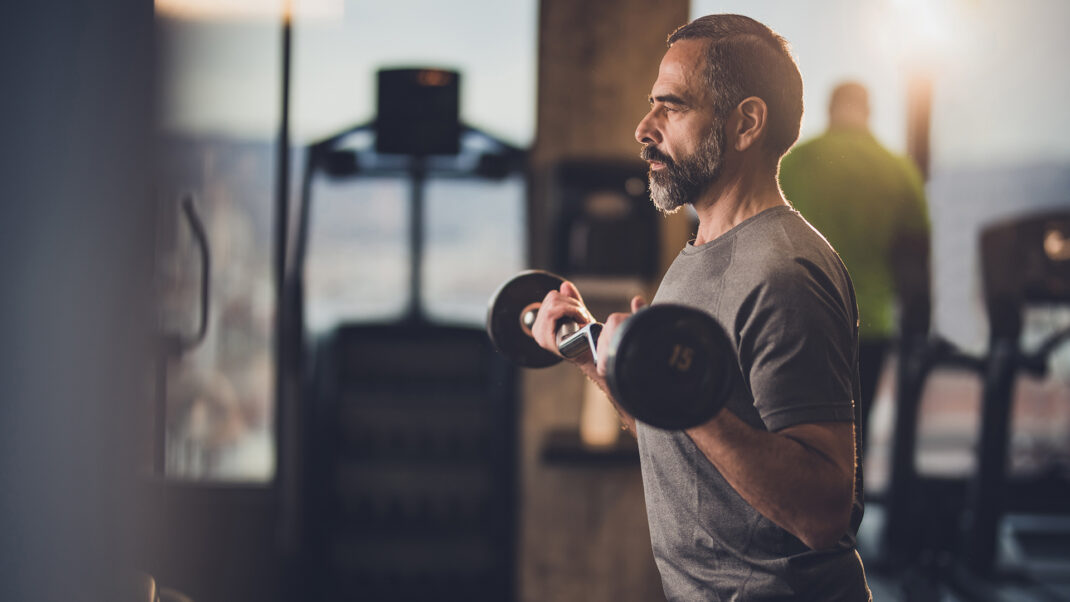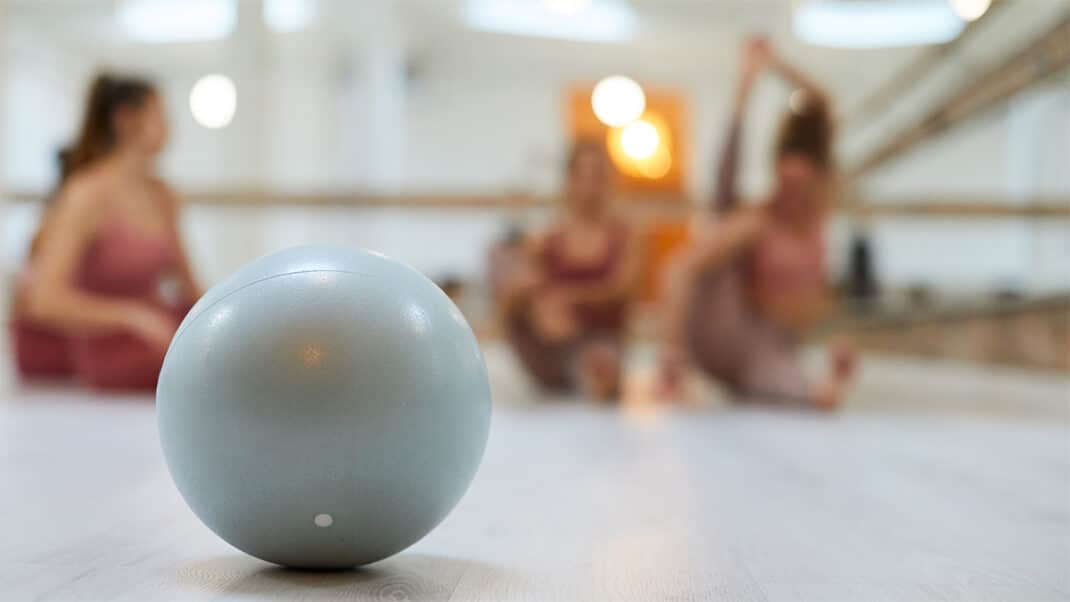HIIT Cycling With a Side of Strength
Combine two effective workouts in one efficient class.

The gym is usually made up of two camps: the cardio junkies who rarely touch a dumbbell and don’t feel like they’ve had a workout unless they’re dripping in sweat, and the committed lifters who can do a pistol squat on command but give cardio machines a wide berth. As a fitness professional, you know that any well-rounded program includes both cardiovascular and resistance training, so how do you bridge the gap for participants? Try HIIT cycling with strength.
Combination classes—also known as “hybrid” or “fusion”—are the answer. One idea is to pair indoor cycling with functional body-weight strength moves to offer the best of both worlds in one efficient, effective class. The first step is convincing people in the cardio and strength camps to give each other’s favorite modality a try.
Benefits of HIIT Cycling
Cardio fans know that getting your heart pumping not only burns calories but also helps build a strong cardiovascular system, among many other science-backed benefits. Indoor cycling provides the opportunity to do high-intensity intervals with minimal impact, compared with running or plyometrics.
High-intensity intervals—short, intense exercise bouts alternated with shorter rest periods—have been found to increase aerobic and anaerobic capacity. When done at maximum effort, this style of training is also an efficient way to burn fat, which can help reveal muscle definition.
HIIT intervals on the bike can take many forms, and the ability to vary resistance adds a challenging element. The traditional Tabata protocol calls for 20 seconds of all-out work, alternated with 10 seconds of rest (20:10), repeated eight times, with 1 minute of rest before the next set. Other ratios, such as 30:15 and 40:20, are also effective.
The key to effective HIIT sets is to encourage participants to work at their highest possible level during the work phase (a 9 or 10 on the rating of perceived exertion scale, or “breathless”). During the rest phase, encourage people to truly rest so they can be ready for the next work bout.
Working at the highest possible level and then resting can be hard for participants who are used to endurance workouts because they’re adept at conserving their energy over a longer span of time. In fact, they’re usually fighting the urge to rest. Convince them to give it a try. After all, the first interval feels different than the 15th, and the benefits can be felt all day long.
Another perspective: Feel-ing breathless can be very uncomfortable for strength fans who are used to taking their time to recover before the next set. The short rest taken between HIIT intervals isn’t designed for feeling rested and ready; it’s a brief reprieve to gather a bit of energy before the next push. Encourage lifters to embrace the uncomfortable feeling of being breathless and to envision that the work is akin to handing a dumbbell to the heart: Every time they complete an interval, it’s like completing a set of reps.
See also: Indoor Cycling by Science
Benefits of Body-Weight Work
Load-lifting devotees know that resistance training is a great way to sculpt muscles, but the benefits extend beyond that. Strong muscles fortify joints, and lean tissue increases resting metabolic rate, just to name two of many pros.
People who are used to adding an external load might underestimate the benefits of a body-weight workout, which can be a great way to change up a traditional routine. This method overloads muscles in new ways by adding dynamic movements that also train balance and flexibility. With body-weight workouts, you can play with time under tension and increase difficulty by slowing exercises down or speeding them up.
Cardio fans might be intimidated by the new challenge posed by different patterns of movement. Remind them how important it is to keep the body balanced. A whole-body strength routine is “insurance” against injuries, and it still offers the endorphin rush people love.
Let’s combine these two training aspects in a fast and fun class that’s easy to replicate and change.
See also: Boost Intensity With a Body-Weight Ladder Workout
The HIIT Cycling Programming Plan

The goal is to scorch calories, challenge the cardiovascular system and deliver a whole-body strength workout.
This program is about 50 minutes long, divided into 25 minutes of indoor cycling, immediately followed by 25 minutes of body-weight strength work. Although HIIT intervals deliver peaks and valleys, the workout follows a traditional bell-shaped curve where intensity increases toward the end of the cycling portion and beginning of the strength section, and then tapers off.
The goal is to scorch calories, challenge the cardiovascular system and deliver a whole-body strength workout.
The Cycling Phase
Warmup: Slowly increase tension at an easy pace. Preview what’s ahead in both the cycling and strength portions. This is also a good time to cue riders to find a couple of resistance levels they can revisit during the workout: one that’s light but firm and another that’s a couple of “turns” heavier than that. Cue rolling hills as a way for participants to get a feel for these resistance levels.
HIIT cycling: Here is where the HIIT intervals come into play.
Build the intervals in a deliberate, escalating way. There are so many ways to vary pushes. You could begin with shorter work periods and increase to longer bursts, or increase tension during a longer rest phase to elevate the challenge on the next set. In the sample workout (left), the intervals remain the same, and the effort increases the workload.
End with some form of pedaling against heavy resistance. This will help stimulate muscle fiber recruitment at the peak and prepare riders for the strength section. With legs already fatigued, the muscles will be set up for overload.
The Strength Phase
Transition: After cycling, everyone is already warm and ready to work, but be on the lookout for “Jell-O legs,” which may cause balance problems. Start the strength routine with lower-body work that uses a large range of motion. This will continue to recruit the greatest number of fibers while requiring less balance, but always offer modifications, especially considering fatigue may be an issue.
Strength sets: For each set, pair two exercises that work different muscle groups, such as squats and pushups or planks and back extensions. This allows one muscle group to rest while the other is working. Alternate the two moves, completing enough reps to cause fatigue before moving to the other. Also alternate between sets two to four times to create a mini circuit that keeps participants moving, interested and engaged.
Start the strength phase with large movements that use big muscle groups, such as lunges and mountain climbers. End with exercise combinations that focus on smaller movements like crunches and bridge.
See also: Cycling + Off-Bike Strength: Combo Class
Keep Participants Fit
Instead of preaching to participants about the importance of lifting weights or doing cardio, teach an accessible class that includes both. This format is intense, so don’t be surprised if those who’ve allowed their training to become rote are surprised at how hard it is. Remind them that it may never feel easy, but they will improve both their strength and aerobic capacity and reap the rewards of this worthy work.
Sample Class: Cycle + Strength Class
Cycling
- Start with a 5-minute warmup.
- Establish two levels of tension: one that’s light but firm enough to keep steady in the saddle and one that’s heavy enough to challenge but allows for a tough sprint interval.
- All intervals are 20 seconds of work and 10 seconds of rest.
- Repeat 8 times to equal a 4-minute set of all-out work, followed by 1 minute of light, easy pedaling before the next set (5 minutes total for each round).
- Tabata one: 20:10 at light tension (8x); 1 minute rest
- Tabata two: 20:10 at light tension (4x) + 20:10 at heavy tension (4x); 1 minute rest
- Tabata three: 20:10 at heavy tension (8x); 1 minute rest at heavy tension
- Tabata four: 20:10 at heavy to heavier tension (8x); 1 minute recovery at heavy tension. When it’s time to work, pump up the resistance and maintain a steady rpm that’s hard to hold. Let the resistance create the push in this interval. When it’s time to rest, decrease tension to the “heavy” setting
(established at the beginning of class) for a loaded rest interval before pumping it up again. - Cooldown/transition: Cue an “easy road” to bring heart rates down before getting off the bike. Participants will feel heavy muscle-fiber recruitment in addition to their high heart rates, and they’ll be ready to get off the bike for strength work.
Strength
- An example of two exercises that would make a good pair to begin the strength portion are alternating lunges and walk-down pushups.
- Alternating lunges allow for the thigh and glute muscles to continue firing, with the added range of motion challenge and loss of pedal momentum. It’s a great opportunity to play with pace. For example, you could say, “Step forward, lower down, pulse four times, rise up, step back. Keep lunging until fatigued, and remember you have another set coming after the pushups.”
- Walk-down pushups offer a dynamic whole-body sequence that will keep heart rates from falling. Lower into a squat, place hands on the floor, and walk forward into high plank, bracing the abdominals. Do a set of pushups—anywhere from one or two slow ones to 10 quick reps. Bend the knees while walking hands back toward the feet into a deep squat, then rise to standing.
- When fatigue sets in and if time permits, stack these moves with other large muscle group moves such as squat variations, planks or even mountain climbers. To finish, focus on smaller muscle groups.
- Cooldown:
- Two exercises that pair well for a cooldown sequence are dead bug and single-leg pulsing bridge. The dead bug starts on the back, with hands and feet straight up, pointed at the ceiling. While keeping the core engaged, lower the right arm and left leg toward the ground as far as possible without the lower back breaking contact with the ground, holding tight through the deep abdominals. Return the arm and leg to the starting position and repeat with left arm and right leg.
- After a good set of dead bugs, the hip flexors may be fatigued. Take the bridge as an opportunity to open up the hips while engaging the gluteals and hamstrings.
- Press up into a bridge with feet rather close together. If possible, remove one foot and extend the leg, reaching the foot toward the ceiling. Push through the ground foot, opening the hip to the ceiling with tiny pulses, keeping hips as level as possible. Once fatigued, lower and repeat on the other side.
- Remember to cool down with a stretching sequence that includes a special focus on the hips, since they are particularly taxed over the course of this workout.
PRO TIP: Modify for Every Level
Indoor cycling and strength training are both low-impact and effective body-changing workouts, but they can be intimidating for beginners. With expert coaching, you can teach a class that challenges every participant at their current level of fitness—with room to push and improve.
During the cycling section, let beginners know that it’s okay if they don’t look like the experienced rider next to them. Even at a lower tension or slower speed, their heart is getting the same benefits if they are pushing themselves out of their comfort zone. Allow them to work at their own level, and let them know it’s okay to skip every other HIIT interval, if needed.
In the strength portion, it’s impossible to deliver a personalized workout to each person. The best way to make sure everyone selects the best level for them is to teach each move as a progression. Never start at the end, but rather build toward the final sequence. Give a base move and make sure everyone has it down. Then make it incrementally more difficult. The exercise can get bigger. You can add some balance, play with the speed or link two movements together. Remind your class it’s okay to stay with the initial movement, go back a level if they are losing form, or take a break. Making a tough class work for every level is the badge of a true professional.
Pamela Light, MA
Pamela Light is a group fitness instructor and personal trainer in Rancho Palos Verdes, CA with a bachelor’s in Exercise Physiology, a Master’s in writing, and 25 years’ experience in the fitness industry. You can find videos of Tape Box workouts in her Facebook group, Pamela’s Light and Fit Community.





